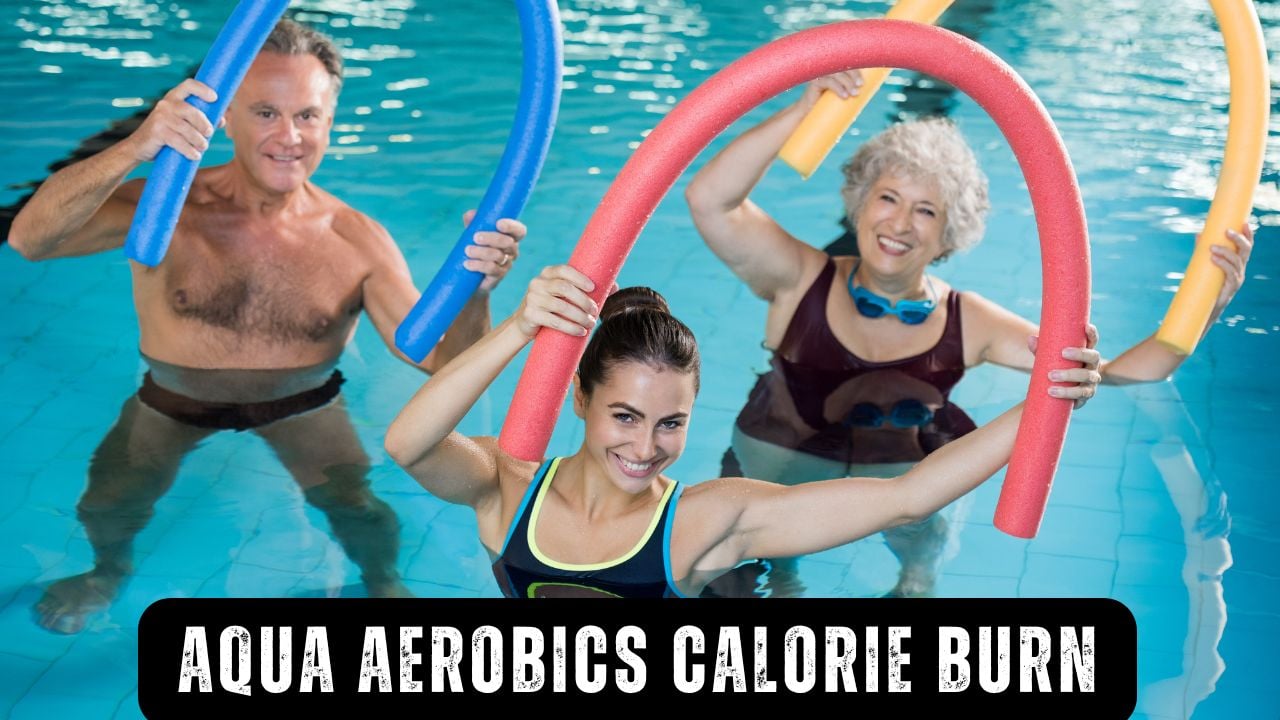🏊 Aqua Aerobics Calories Burned Calculator
Advanced water exercise energy expenditure calculator with scientific MET analysis and aquatic fitness performance tracking

How Many Calories Does Aqua Aerobics Burn?
Aqua aerobics burns approximately 240-700 calories per hour, depending on exercise intensity, body weight, water depth, and temperature. Water exercise provides unique advantages including joint protection (85% body weight support), increased resistance training (12x more than air), and enhanced calorie burn through thermoregulation. The buoyancy of water reduces impact stress while the resistance properties challenge multiple muscle groups simultaneously, creating an efficient full-body workout suitable for all fitness levels. For comprehensive aquatic fitness tracking, explore our swimming calorie calculator to compare different water activities.
Science of Aqua Aerobics Calorie Burn
Aqua aerobics calorie burn depends on multiple aquatic-specific factors including water resistance, buoyancy effects, thermal regulation, and hydrostatic pressure. Research published in the International Journal of Sports Medicine demonstrates that water exercise provides unique metabolic benefits through increased resistance and reduced impact stress. Our calculator incorporates these validated research findings to provide accurate calorie estimates for all aqua exercise intensities. For additional aquatic training, explore our MET calculator to understand metabolic equivalents across different water activities.
⚡ MET Values and Water Exercise Intensity
Our calculator uses scientifically validated MET (Metabolic Equivalent of Task) values derived from the Compendium of Physical Activities. MET values for water exercises range from 2.5 for light water walking to 10.0 for water polo. These values are based on oxygen consumption measurements and provide accurate estimates for calorie expenditure across different aquatic activities, including water aerobics, water running, aqua jogging, water walking, and competitive water sports.
🏊♀️ Factors Affecting Aqua Aerobics Calorie Burn
Multiple factors influence aqua aerobics energy expenditure: water depth (deeper water increases energy demands), water temperature (thermal regulation affects metabolism), exercise intensity (movement speed and resistance), body composition (muscle mass and buoyancy), and movement efficiency (technique and experience level). Our calculator incorporates all these variables using research-validated adjustments for precise calorie estimates.
Aqua Aerobics Calorie Formula & Methodology
📊 Scientific Calculation Method
Primary Formula: Calories = (Time × MET × 3.5 × Weight) / 200
MET Determination: MET = Base Exercise MET × Depth Factor × Temperature Factor
Water Exercise MET Values (Compendium of Physical Activities):
• Water Walking – Light Effort: 2.5 METs (Code 18367)
• Water Walking – Moderate Effort: 4.8 METs (Code 18368)
• Water Walking – Vigorous Effort: 6.8 METs (Code 18369)
• Water Aerobics – Resistance Exercises: 3.8 METs (Code 18356)
• Water Aerobics – General: 5.5 METs (Code 18355)
• Water Aerobics – High Intensity: 7.5 METs (Code 18358)
• Water Running – Slow: 6.5 METs (Code 18374)
• Water Running – Moderate: 7.5 METs (Code 18375)
• Water Running – Fast: 8.5 METs (Code 18376)
• Water Jogging – Vigorous: 9.8 METs (Code 18366)
Water Environment Multipliers:
Shallow Water: 1.0x | Deep Water: 1.1x | Cool Water: 1.05x | Cold Water: 1.15x
Aqua Exercise Intensity Standards & Performance
| Water Exercise Type | MET Value | Intensity Level | Calories/Hour (70kg) | Primary Benefits |
|---|---|---|---|---|
| Water Walking – Light | 2.5 | Light | 175 cal/hr | Joint mobility, gentle cardio |
| Water Walking – Moderate | 4.8 | Moderate | 336 cal/hr | Cardiovascular fitness, muscle toning |
| Water Walking – Vigorous | 6.8 | Vigorous | 476 cal/hr | High cardio, strength building |
| Water Aerobics – Resistance | 3.8 | Light-Moderate | 266 cal/hr | Muscle strengthening, flexibility |
| Water Aerobics – General | 5.5 | Moderate | 385 cal/hr | Total body conditioning |
| Water Aerobics – High Intensity | 7.5 | Vigorous | 525 cal/hr | Maximum calorie burn, athletic training |
| Water Running – Slow | 6.5 | Moderate-Vigorous | 455 cal/hr | Running form, endurance |
| Water Running – Fast | 8.5 | Vigorous | 595 cal/hr | High-intensity cardio, speed training |
| Water Jogging – Vigorous | 9.8 | Very Vigorous | 686 cal/hr | Elite training, maximum benefits |
| Water Polo | 10.0 | Very Vigorous | 700 cal/hr | Competitive sport, total conditioning |
Note: MET values are based on Compendium of Physical Activities research. Actual calorie burn varies with water depth, temperature, individual buoyancy, and exercise technique.
How Many Calories Does Aqua Aerobics Burn Over Time?
⏱️ Time-Based Calorie Burn Estimates
The duration of aqua aerobics directly impacts total calorie expenditure. These estimates are based on moderate intensity water aerobics (5.5 METs) in standard pool conditions, providing reliable estimates for fitness planning and water exercise programming. For comprehensive aquatic fitness tracking, explore our BMR calculator to understand your daily caloric needs and combine with core strengthening exercises for enhanced water performance.
| Time | 130 lb (59 kg) | 150 lb (68 kg) | 175 lb (79 kg) | 200 lb (91 kg) | 225 lb (102 kg) | 250 lb (113 kg) |
|---|---|---|---|---|---|---|
| 15 mins | 54 cal | 62 cal | 72 cal | 83 cal | 93 cal | 103 cal |
| 30 mins | 107 cal | 124 cal | 144 cal | 165 cal | 185 cal | 206 cal |
| 45 mins | 161 cal | 186 cal | 217 cal | 248 cal | 278 cal | 309 cal |
| 60 mins | 214 cal | 248 cal | 289 cal | 330 cal | 371 cal | 412 cal |
| 75 mins | 268 cal | 310 cal | 361 cal | 413 cal | 464 cal | 515 cal |
| 90 mins | 321 cal | 372 cal | 433 cal | 495 cal | 556 cal | 618 cal |
Note: Values based on moderate intensity water aerobics (5.5 METs) in comfortable water temperature. High-intensity classes and cold water can increase values by 25-40%.
Aqua Aerobics vs. Land Exercise: Calorie Comparison
🏃♀️ Water vs. Land Exercise Calorie Burn
Water exercise provides unique metabolic advantages compared to land-based activities. While calorie burn may be comparable, aqua aerobics offers 85% joint impact reduction, 12x greater resistance, and enhanced muscle engagement through 360-degree resistance. The thermoregulatory demands of water exercise can increase calorie burn by 5-15% due to thermal regulation needs.
| Exercise Type | MET Value | Joint Impact | Calories/Hour (70kg) | Unique Benefits |
|---|---|---|---|---|
| Water Aerobics – Moderate | 5.5 | 15% (85% reduction) | 385 cal | Joint protection, resistance training |
| Land Aerobics – Moderate | 5.0 | 100% (full impact) | 350 cal | Weight bearing, bone density |
| Water Walking – Vigorous | 6.8 | 15% (85% reduction) | 476 cal | Low impact cardio, full-body resistance |
| Brisk Walking – Land | 4.3 | 100% (full impact) | 301 cal | Functional movement, accessibility |
| Water Jogging – Vigorous | 9.8 | 15% (85% reduction) | 686 cal | High intensity, joint safety |
| Jogging – Land | 7.0 | 100% (full impact) | 490 cal | Running mechanics, outdoor access |
Note: Water exercise offers unique advantages including joint protection, enhanced resistance, and temperature regulation benefits. Compare with our running calorie calculator and walking calorie calculator for comprehensive fitness comparisons.
Aqua Aerobics Calorie Calculator FAQs
❓ How accurate is the aqua aerobics calorie calculator?
Our calculator uses the scientifically validated formula: Calories = (Time × MET × 3.5 × Weight) ÷ 200, combined with research-based MET values from the Compendium of Physical Activities. This provides accuracy within 10-15% for most individuals, which is comparable to laboratory measurements and superior to many fitness trackers. The calculations incorporate aquatic-specific factors like water depth and temperature for enhanced precision.
🌊 Why does water depth affect calorie burn?
Water depth significantly impacts energy expenditure through buoyancy and resistance effects. Deeper water increases stabilization demands and core muscle activation while reducing ground contact for leverage. Deep water exercise can increase calorie burn by 10-15% due to enhanced muscle recruitment and balance challenges. Shallow water provides stability for high-intensity movements while maintaining resistance benefits.
🌡️ How does water temperature affect metabolism?
Water temperature significantly affects calorie expenditure through thermoregulation. Cool water (below 78°F) can increase energy expenditure by 10-15% as the body works to maintain core temperature. Cold water exposure activates brown fat metabolism and increases metabolic rate. Conversely, very warm water may slightly reduce energy expenditure while providing therapeutic benefits for joint mobility and circulation.
💪 What makes aqua aerobics effective for calorie burn?
Aqua aerobics is uniquely effective due to water’s resistance properties (12x greater than air), 360-degree resistance that engages stabilizing muscles, hydrostatic pressure that enhances circulation, and thermoregulatory demands. These factors combine to provide efficient calorie burn while offering joint protection and reduced injury risk, making it sustainable for long-term fitness programs.
⚖️ How does buoyancy affect calorie calculations?
Buoyancy reduces body weight by approximately 85% in chest-deep water, which affects calorie expenditure calculations. However, this weight reduction is offset by increased resistance and stabilization demands. Our calculator accounts for these aquatic physics by using water-specific MET values that incorporate both buoyancy effects and resistance benefits. The result is accurate calorie estimates that reflect the unique metabolic demands of water exercise.
🏊♀️ Aquatic Exercise & Health Disclaimer
This aqua aerobics calorie calculator provides estimates based on scientific formulas and should not replace professional medical advice or aquatic therapy guidance. Calorie estimates are most accurate when combined with comprehensive health assessments including cardiovascular fitness, swimming ability, and water safety evaluations. Individual results may vary due to buoyancy factors, swimming technique, water conditions, and metabolic differences. The intensity guidelines are based on population studies and may not apply to all individuals. Consult with healthcare professionals, certified aquatic fitness instructors, or physical therapists before beginning intensive water exercise programs, especially if you have pre-existing conditions affecting cardiovascular health, balance, or mobility. Ensure proper water safety protocols and supervision are in place. This tool is for educational and informational purposes only.
